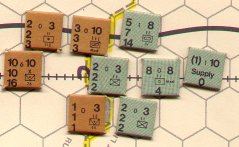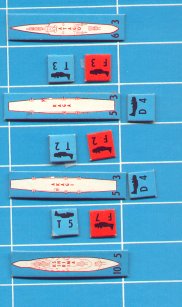Cardboard Heroes

Cardboard soldiers don't bleed cardboard blood. They don't lose cardboard eyes or cardboard legs or cardboard arms. There are no cardboard families grieving for their cardboard sons; no cardboard senators railing against high casualty rates; no cardboard press sending home pictures from the font. There are no cardboard Quakers.
Instead, our cardboard soldiers follow orders, and march willingly to their deaths in the hope that they'll be resurrected from cardboard oblivion as replacements on the next turn.
Of course this is all abstraction. Divisions are rarely, if ever, sacrificed to the last man to ensure a favorable outcome ten miles away. Nor do they magically reappear behind the lines a week later, rested, re-armed and ready to enter the fray as if nothing happened. But we need some method of representing victory and defeat in our skirmishes and wholesale elimination of units is tried and true.
Some games have addressed the issue of complete elimination by introducing step reduction systems. These either becomes a bookkeeping nightmare, or requires 2, 3, 4 or more times the number of counters to handle the quantitative differences involved. Typically this introduces the concept of replacements, and cardboard replacements are another wonder.
Added to an elite formation, cardboard replacements immediately act like battle hardened veterans. The same cardboard replacement added to a conscript regiment turns and runs at the first sound of gunfire. Which brings us to another interesting behavior pattern of cardboard soldiers.

A mere moment ago, our cardboard soldiers were in head long retreat, now they are the key component in a counter-attack which cuts off the schwerpunkt, trapping an entire armored corps behind enemy lines -- and right after they're in retreat again. Sometimes our cardboard soldiers are tough as nails, at other times they behave like raw recruits.
When we have an exceptionally strong unit in our counter mix, we tend to use it constantly without rest or refit. Cardboard solders can do this. They don't get tired, they never complain, they're good soldiers and they follow orders, no matter how unrealistic our expectations may be.
And all the while we delude ourselves into thinking we are engaging in a realistic simulation of a particular battle or war.
These problems can be addressed. If, in addition to offensive and defensive strengths, we also tracked morale, exhaustion; if we use a step reduction system to reflect casualties; if we allow for battle hardening, we can improve our simulations. But keeping track of all the variables tends to force us to spend more time in bookkeeping than we do in maneuvering.
The obvious solution is the computer. It can accurately track dozens of variables, work its way through complex formulas to resolve firefights, and still have processing power left over to play a CD in the background and display animations on the screen. But as you'll see if you work your way through this site, the current state of the art in computer wargaming leaves much to be desired.
Page Last Updated 04/30/99
Cardboard Heroes | E-mail DaveThis page has been visited times
since April, 30, 1999.